初中英语名词的单数和复数
初中英语知识点归纳名词的单复数规则
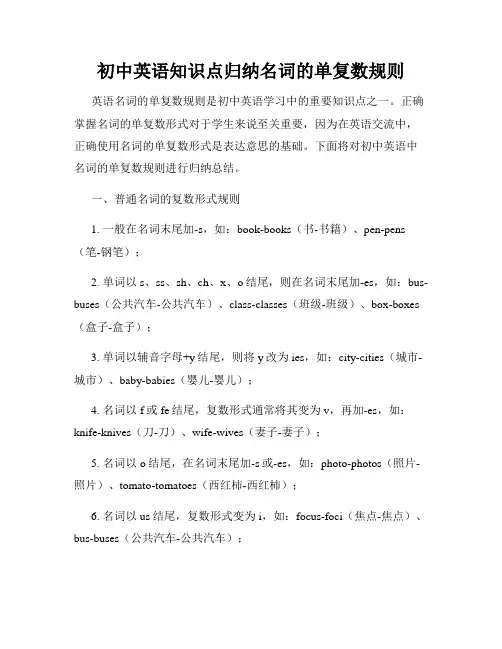
初中英语知识点归纳名词的单复数规则英语名词的单复数规则是初中英语学习中的重要知识点之一。
正确掌握名词的单复数形式对于学生来说至关重要,因为在英语交流中,正确使用名词的单复数形式是表达意思的基础。
下面将对初中英语中名词的单复数规则进行归纳总结。
一、普通名词的复数形式规则1. 一般在名词末尾加-s,如:book-books(书-书籍)、pen-pens (笔-钢笔);2. 单词以s、ss、sh、ch、x、o结尾,则在名词末尾加-es,如:bus-buses(公共汽车-公共汽车)、class-classes(班级-班级)、box-boxes (盒子-盒子);3. 单词以辅音字母+y结尾,则将y改为ies,如:city-cities(城市-城市)、baby-babies(婴儿-婴儿);4. 名词以f或fe结尾,复数形式通常将其变为v,再加-es,如:knife-knives(刀-刀)、wife-wives(妻子-妻子);5. 名词以o结尾,在名词末尾加-s或-es,如:photo-photos(照片-照片)、tomato-tomatoes(西红柿-西红柿);6. 名词以us结尾,复数形式变为i,如:focus-foci(焦点-焦点)、bus-buses(公共汽车-公共汽车);7. 名词以is结尾,复数形式变为es,如:analysis-analyses(分析-分析)、thesis-theses(论文-论文)。
二、特殊名词的复数形式规则1. 名词本身已经是复数形式,如:pants(裤子)、scissors(剪刀);2. 名词的单数和复数形式相同,如:sheep(羊)、deer(鹿);3. 名词有不规则的复数形式,如:man-men(男人-男人)、woman-women(女人-女人);4. 名词是由“名词+名词”的形式构成,只有第一个名词变为复数形式,如:brother-in-law-brothers-in-law(姐夫-兄弟们);5. 名词是由“名词+of+名词”的形式构成,只有第一个名词变为复数形式,如:cup of tea-cups of tea(一杯茶-几杯茶);6. 名词是由“名词+a/an+形容词”的形式构成,只有第一个名词变为复数形式,如:a pair of shoes-pairs of shoes(一双鞋-几双鞋)。
初中英语名词单复数变化知识点总结
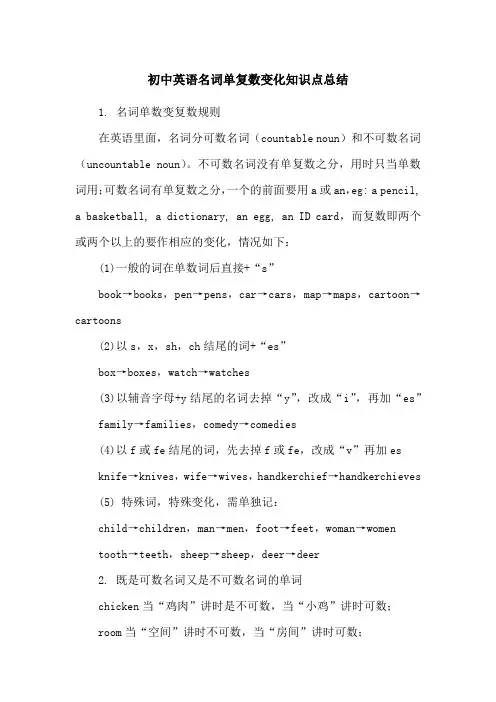
初中英语名词单复数变化知识点总结1. 名词单数变复数规则在英语里面,名词分可数名词(countable noun)和不可数名词(uncountable noun)。
不可数名词没有单复数之分,用时只当单数词用;可数名词有单复数之分,一个的前面要用a或an,eg: a pencil, a basketball, a dictionary, an egg, an ID card,而复数即两个或两个以上的要作相应的变化,情况如下:(1)一般的词在单数词后直接+“s”book→books,pen→pens,car→cars,map→maps,cartoon→cartoons(2)以s,x,sh,ch结尾的词+“es”box→boxes,watch→watches(3)以辅音字母+y结尾的名词去掉“y”,改成“i”,再加“es”family→families,comedy→comedies(4)以f或fe结尾的词,先去掉f或fe,改成“v”再加esknife→knives,wife→wives,handkerchief→handkerchieves(5) 特殊词,特殊变化,需单独记:child→children,man→men,foot→feet,woman→womentooth→teeth,sheep→sheep,deer→deer2. 既是可数名词又是不可数名词的单词chicken当“鸡肉”讲时是不可数,当“小鸡”讲时可数;room当“空间”讲时不可数,当“房间”讲时可数;fish当食物用“鱼、鱼肉”讲时不可数,当“鱼的种类”讲时可数;hair泛指“毛发”时不可数,当“一根或几根毛发”讲时可数;sound意思是“一般性的声音”时,不可数,指“一次发出的声音”时可数;paper当“纸”讲时不可数,当“试卷”、“论文”、“证件”讲时可数;time当“时间”讲时不可数,当“时代、倍数、次数”讲时可数;exercise泛指“锻炼”时不可数,当“练习、做操”讲时可数。
初中英语知识点归纳名词的单复数变化与用法
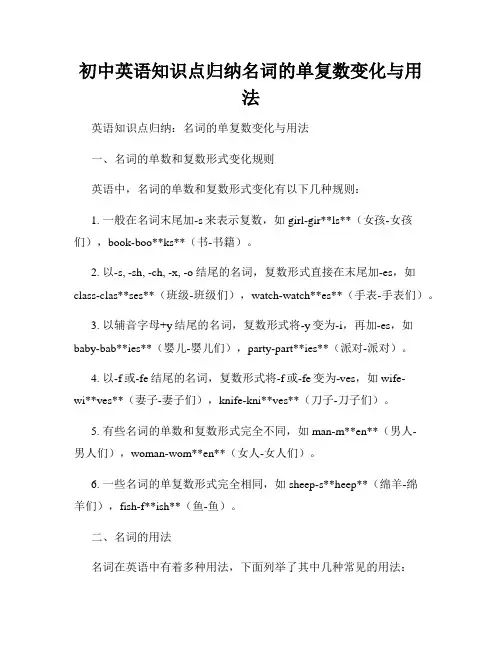
初中英语知识点归纳名词的单复数变化与用法英语知识点归纳:名词的单复数变化与用法一、名词的单数和复数形式变化规则英语中,名词的单数和复数形式变化有以下几种规则:1. 一般在名词末尾加-s来表示复数,如girl-gir**ls**(女孩-女孩们),book-boo**ks**(书-书籍)。
2. 以-s, -sh, -ch, -x, -o结尾的名词,复数形式直接在末尾加-es,如class-clas**ses**(班级-班级们),watch-watch**es**(手表-手表们)。
3. 以辅音字母+y结尾的名词,复数形式将-y变为-i,再加-es,如baby-bab**ies**(婴儿-婴儿们),party-part**ies**(派对-派对)。
4. 以-f或-fe结尾的名词,复数形式将-f或-fe变为-ves,如wife-wi**ves**(妻子-妻子们),knife-kni**ves**(刀子-刀子们)。
5. 有些名词的单数和复数形式完全不同,如man-m**en**(男人-男人们),woman-wom**en**(女人-女人们)。
6. 一些名词的单复数形式完全相同,如sheep-s**heep**(绵羊-绵羊们),fish-f**ish**(鱼-鱼)。
二、名词的用法名词在英语中有着多种用法,下面列举了其中几种常见的用法:1. 主语:名词可以作为句子的主语,如"**Cats** are my favorite animals."(猫是我最喜欢的动物)。
2. 宾语:名词可以作为句子的宾语,接受动作的影响,如"I love **dogs**."(我喜欢狗)。
3. 定语:名词可以作为另一个名词的定语,用来限定其意义,如"**Book** store"(书店)。
4. 表语:名词可以作为系动词的表语,说明主语的身份、性质等,如"The girl is a **student**."(这个女孩是一名学生)。
初中名词的单复数形式及其用法区别
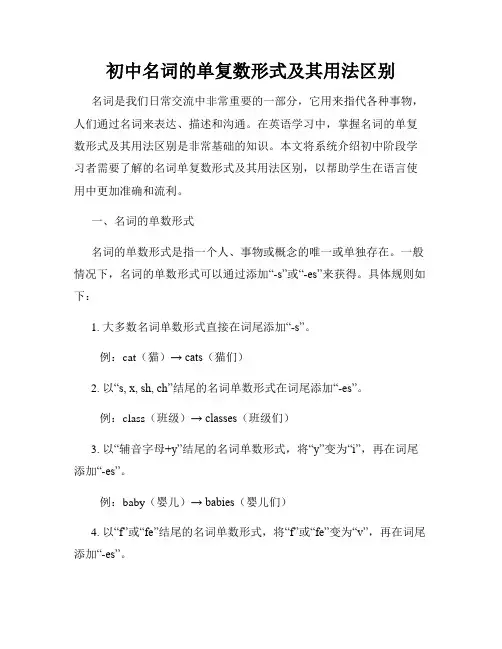
初中名词的单复数形式及其用法区别名词是我们日常交流中非常重要的一部分,它用来指代各种事物,人们通过名词来表达、描述和沟通。
在英语学习中,掌握名词的单复数形式及其用法区别是非常基础的知识。
本文将系统介绍初中阶段学习者需要了解的名词单复数形式及其用法区别,以帮助学生在语言使用中更加准确和流利。
一、名词的单数形式名词的单数形式是指一个人、事物或概念的唯一或单独存在。
一般情况下,名词的单数形式可以通过添加“-s”或“-es”来获得。
具体规则如下:1. 大多数名词单数形式直接在词尾添加“-s”。
例:cat(猫)→ cats(猫们)2. 以“s, x, sh, ch”结尾的名词单数形式在词尾添加“-es”。
例:class(班级)→ classes(班级们)3. 以“辅音字母+y”结尾的名词单数形式,将“y”变为“i”,再在词尾添加“-es”。
例:baby(婴儿)→ babies(婴儿们)4. 以“f”或“fe”结尾的名词单数形式,将“f”或“fe”变为“v”,再在词尾添加“-es”。
例:wife(妻子)→ wives(妻子们)5. 以“o”结尾的名词单数形式,大多数在词尾添加“-s”。
例:photo(照片)→ photos(照片们)二、名词的复数形式名词的复数形式是指表示多个人、事物或概念的形式。
除了上述名词单数形式的规则外,还有一些特殊的复数形式需要注意。
具体规则如下:1. 以“-y”结尾的名词单数形式,将“y”变为“-ies”。
例:baby(婴儿)→ babies(婴儿们)2. 以“-s, -ss, -sh, -ch, -x”结尾的名词单数形式,一般在词尾添加“-es”。
例:class(班级)→ classes(班级们)3. 以“-f”或“-fe”结尾的名词单数形式,将“f”或“fe”变为“v”,再在词尾添加“-es”。
例:wife(妻子)→ wives(妻子们)4. 另外,一些名词的复数形式与其单数形式完全不同。
初中英语单复数知识点总结
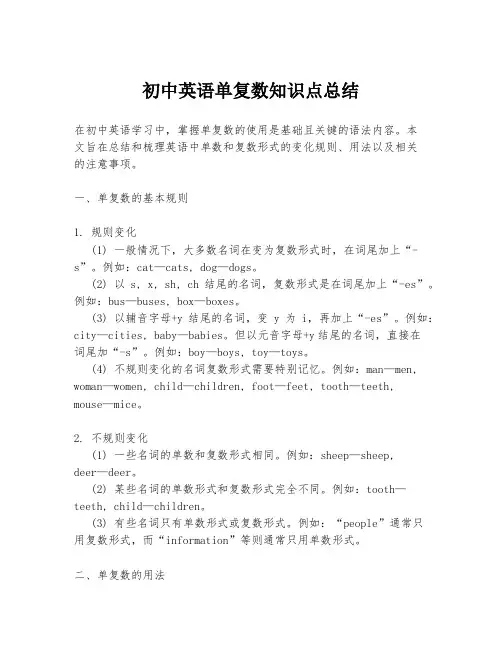
初中英语单复数知识点总结在初中英语学习中,掌握单复数的使用是基础且关键的语法内容。
本文旨在总结和梳理英语中单数和复数形式的变化规则、用法以及相关的注意事项。
一、单复数的基本规则1. 规则变化(1) 一般情况下,大多数名词在变为复数形式时,在词尾加上“-s”。
例如:cat—cats, dog—dogs。
(2) 以s, x, sh, ch结尾的名词,复数形式是在词尾加上“-es”。
例如:bus—buses, box—boxes。
(3) 以辅音字母+y结尾的名词,变y为i,再加上“-es”。
例如:city—cities, baby—babies。
但以元音字母+y结尾的名词,直接在词尾加“-s”。
例如:boy—boys, toy—toys。
(4) 不规则变化的名词复数形式需要特别记忆。
例如:man—men, woman—women, child—children, foot—feet, tooth—teeth, mouse—mice。
2. 不规则变化(1) 一些名词的单数和复数形式相同。
例如:sheep—sheep, deer—deer。
(2) 某些名词的单数形式和复数形式完全不同。
例如:tooth—teeth, child—children。
(3) 有些名词只有单数形式或复数形式。
例如:“people”通常只用复数形式,而“information”等则通常只用单数形式。
二、单复数的用法1. 确定名词数量(1) 使用单数名词表示一个或泛指某一类中的一个。
例如:An apple is healthy.(一个苹果是健康的。
)(2) 使用复数名词表示两个或两个以上的。
例如:Apples are good for your health.(苹果对你的健康有益。
)2. 量词的使用(1) 可数名词在使用时通常需要搭配量词。
例如:a book, two books。
(2) 量词的单复数形式也需要与后面的名词保持一致。
初中英语知识点归纳名词的单复数形式
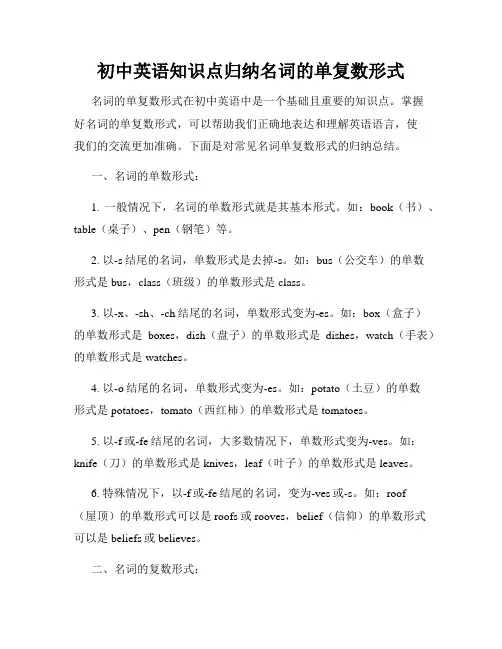
初中英语知识点归纳名词的单复数形式名词的单复数形式在初中英语中是一个基础且重要的知识点。
掌握好名词的单复数形式,可以帮助我们正确地表达和理解英语语言,使我们的交流更加准确。
下面是对常见名词单复数形式的归纳总结。
一、名词的单数形式:1. 一般情况下,名词的单数形式就是其基本形式。
如:book(书)、table(桌子)、pen(钢笔)等。
2. 以-s结尾的名词,单数形式是去掉-s。
如:bus(公交车)的单数形式是bus,class(班级)的单数形式是class。
3. 以-x、-sh、-ch结尾的名词,单数形式变为-es。
如:box(盒子)的单数形式是boxes,dish(盘子)的单数形式是dishes,watch(手表)的单数形式是watches。
4. 以-o结尾的名词,单数形式变为-es。
如:potato(土豆)的单数形式是potatoes,tomato(西红柿)的单数形式是tomatoes。
5. 以-f或-fe结尾的名词,大多数情况下,单数形式变为-ves。
如:knife(刀)的单数形式是knives,leaf(叶子)的单数形式是leaves。
6. 特殊情况下,以-f或-fe结尾的名词,变为-ves或-s。
如:roof(屋顶)的单数形式可以是roofs或rooves,belief(信仰)的单数形式可以是beliefs或believes。
二、名词的复数形式:1. 一般情况下,名词的复数形式在其单数形式的基础上添加-s。
如:books(书)、tables(桌子)、pens(钢笔)等。
2. 以-s、-x、-sh、-ch结尾的名词,复数形式变为加-es。
如:buses (公交车)、boxes(盒子)、dishes(盘子)、watches(手表)。
3. 以-o结尾的名词,复数形式变为加-es。
如:potatoes(土豆)、tomatoes(西红柿)。
4. 以-y结尾的名词,变y为i,再加-es。
如:baby(宝宝)的复数形式是babies,country(国家)的复数形式是countries。
初中英语单复数变化规则
初中英语单复数变化规则1)单数名词加s: students, apples, bags, trees, books, brothers.2)以s、x、sh、ch结尾的名词加es: glasses, boxes, brushes, matches.3)以辅音字母加y结尾的名词,变y为i加es: cities, babies, enemies.4)以f或fe结尾的名词,多数变f为v加es: wives, knives.但有些词只加s: roofs, proof s, chiefs.5)以o结尾的名词,有些加es: Negroes, heroes, tomatoes, potatoes.其它加s: radio s, zoos, pianos, photos.6)不规则名词:foot→feet, goose→geese, tooth→teeth, child→children, man→me n, woman→women, sheep→sheep, deer→deer, mouse→mice.7)某些外来词变复数:datum→data, medium→media, bacterium→bacteria, curriculum →curricula, criterion→criteria, phenomenon→phenomena. (um/on→a),analysis→analyses, basis→bases, crisis→crises, diagnosis→diagnoses.(is→es ).8)复合名词变复数:以不可数名词结尾的复合名词无复数形式,如:homework.以man或woman为前缀的复合名词变复数,前后两个名词都变复数,如:manservant→menservants, woman student women students.其它复合名词变复数:grown up→grown ups, brother in law→brothers in law, stand by→stands by.9)复合形容词做定语时,其中的名词保持单数:a six year old boy,a two hundred page book名词复数:英语中名词可分为可数名词和不可数名词。
初中英语名词的单数和复数形式大全(各版本通用)
初中英语名词的单数和复数形式大全(各版本通用)初中英语名词的单数和复数形式大全(各版本通用)一、名词的单数和复数形式规则在英语中,名词的单数和复数形式有一定的规则。
下面是常见的名词单数和复数形式的规则:1. 以辅音字母+y结尾的名词,变复数时,将y改为i,再加-es。
- 例如:baby -> babies2. 以-s,-sh,-ch,-x结尾的名词,变复数时,直接加-es。
- 例如:bus -> buses3. 以-o结尾的名词,变复数时,有两种情况:- 如果o之前是元音字母,直接加-s。
- 例如:radio -> radios- 如果o之前是辅音字母,加-es。
- 例如:potato -> potatoes4. 以-f或-fe结尾的名词,变复数时,将f或fe改为v,再加-es。
- 例如:leaf -> leaves5. 一些不规则名词的复数形式:- 例如:child -> children二、常见名词的单数和复数形式下面是一些常见名词的单数和复数形式的示例:- cat(猫): cats(复数)- dog(狗): dogs(复数)- book(书): books(复数)- table(桌子): tables(复数)- student(学生): students(复数)- teacher(老师): teachers(复数)- city(城市): cities(复数)- country(国家): countries(复数)请注意,以上仅列举了一部分常见名词的单数和复数形式,还有更多名词的单数和复数形式需要根据具体情况进行研究和记忆。
三、注意事项在研究名词的单数和复数形式时,需要注意以下几点:1. 有些名词的复数形式与其单数形式完全相同。
- 例如:sheep(羊):sheep(复数)2. 有些名词只有复数形式,没有单数形式。
- 例如:scissors(剪刀):scissors3. 有些名词既可以作单数,又可以作复数,意思可能有所不同。
初中知识点归纳名词的单复数变化规则
初中知识点归纳名词的单复数变化规则名词是我们日常交流中使用最为频繁的词性之一。
在初中英语学习中,正确使用名词的单复数形式是非常重要的。
本文将为大家归纳总结初中英语中常见名词的单复数变化规则,帮助大家能够更加准确地运用这些知识点。
一、可数名词的变化规则1. 单数名词通常在末尾加-s来表示复数。
例如:- apple - apples- book - books- cat - cats2. 以s, x, ch, sh结尾的名词,复数形式在末尾加-es。
例如:- bus - buses- box - boxes- watch - watches- brush - brushes3. 以辅音字母+y结尾,将y变为i,再加-es。
例如:- family - families- baby - babies4. 以元音字母+y结尾,直接加-s。
例如:- toy - toys- boy - boys- day - days5. 以-f或-fe结尾,变f或fe为v,再加-es。
例如:- leaf - leaves- wolf - wolves6. 以-o结尾的名词,复数形式多数在末尾加-es。
例如:- tomato - tomatoes- potato - potatoes7. 一些名词变复数形式有特殊规则,需要单独记忆。
例如:- woman - women- mouse - mice- tooth - teeth二、不可数名词的变化规则1. 一些名词是不可数名词,即无法用复数形式表示。
这些名词表示一类东西的整体或抽象概念。
例如:- water- milk- knowledge2. 不可数名词一般没有复数形式,所以不需要进行变化。
三、可数名词和不可数名词的混合使用1. 当可数名词和不可数名词一同出现时,通常可数名词前面会加上量词来表示数量。
例如:- three bottles of water- a cup of milk- some items of knowledge2. 注意,在表示时间、空间或者金钱时,可数名词变为复数形式。
初中英语知识点归纳名词的单复数和所有格
初中英语知识点归纳名词的单复数和所有格名词的单复数形式和所有格名词是英语语法中的重要部分,它是用来指代人、事物、地方等概念的词语。
名词有单数形式和复数形式,并且还有所有格的变化。
下面将详细介绍名词的单复数形式和所有格的使用。
一、名词的单数和复数形式1. 名词的复数形式通常在词尾加上-s。
例如:- cat(猫)→ cats(猫们)- book(书)→ books(书们)2. 以s、sh、ch、x结尾的名词,复数形式在词尾加-es。
例如:- box(盒子)→ boxes(盒子们)- brush(刷子)→ brushes(刷子们)3. 以辅音字母+y结尾的名词,复数形式将y变为i,再加-es。
例如:- baby(婴儿)→ babies(婴儿们)- city(城市)→ cities(城市们)4. 以f或fe结尾的名词,复数形式将f或fe变为v,再加-es。
例如:- leaf(叶子)→ leaves(叶子们)- wolf(狼)→ wolves(狼们)5. 一些名词的复数形式不规则,需要直接记忆。
例如:- man(男人)→ men(男人们)- woman(女人)→ women(女人们)- child(孩子)→ children(孩子们)- tooth(牙齿)→ teeth(牙齿们)二、名词的所有格形式名词的所有格表示所属或归属关系,通常在名词后面加上's或'。
下面是使用名词所有格的几种情况:1. 单数名词的所有格:在名词末尾加's。
例如:- Tom's book(汤姆的书)- the teacher's desk(老师的桌子)2. 以s结尾的复数名词的所有格:在名词末尾只加'。
例如:- the cats' toys(猫们的玩具)- the students' books(学生们的书)3. 以其他字母结尾的复数名词的所有格:在名词末尾加's。
- 1、下载文档前请自行甄别文档内容的完整性,平台不提供额外的编辑、内容补充、找答案等附加服务。
- 2、"仅部分预览"的文档,不可在线预览部分如存在完整性等问题,可反馈申请退款(可完整预览的文档不适用该条件!)。
- 3、如文档侵犯您的权益,请联系客服反馈,我们会尽快为您处理(人工客服工作时间:9:00-18:30)。
1.名词复数的规则变化变复数后的读音[iz]2.名词复数的不规则变化①单数与复数同形的名词sheep 绵羊 fish 鱼 deer 鹿 Chinese 中国人 Japanese 日本人②词尾加-en或-renox-oxen 牛 child-children 小孩③改变词内元音字母man - men 男人 woman - women 女人 foot - feet 脚 goose - geese 鹅 tooth - teeth 牙齿 mouse-mice 老鼠一. 名词单数变复数填空1.orange text bed cakecomputer apple house quilt plane tree lesson banana shirt month cup parent2.piano photo radio zoo tomato potato hero negro3.class fox watch glass dress brush box bus4.shelf knife wife life leaf thief wolf5.family country army citystory baby butterfly6.toy day key boy7.sheep fish deer Chinese8.child ox man woman foot goose tooth mouse二.代词/ be动词单数变复数this ______ that _________ I _______ you ________she_______ he ________ it ________ am _____ is _______三:把下列的单词变为复数形式1.key2.boy3.family4.case5.backpack6.dictionary7.watchputer 9.game 10.notebook11.bag 12.math 13.alarm 14.video15.tape 16.hat 17.pear 18.egg19.apple 20.carrot 21.vegetable22.star 23.sock 24.shirt 25.shoe26.skirt 27.sweater 28.clerk29.store 30.shop_________四:句子单数变复数1.This is a book. . __________________________2.That is an eraser. ___________________________3.It is a red apple. ____________________________4.I am a boy. ______________________________5.He / She is a teacher. __________________________6.What’s this? _________________________________五:名词复数变单数练习1:Those are my friends._________________________2: They are English boys. __________________________3: They are some erasers. ________________________4: These are dictionaries. ___________________________5: we are students. ___________________________6: what color are your books ? ______________________六:根据句意及所给单词填空。
1:________(this) are my English books.2: The two boys are my _________(cousin)3: ---- _________those your parents?----Yes, they _________.4: ---Who are the man and the woman in the picture?----They are my __________.5: My aunt Jane and my mother are ___________.6: They are my __________(姨)。
7: I have two ___________(watch). They are on the desk.8: I have some __________(photo) of my family.9: Do you like these ____________(dictionary)?10: Are those your _________(bus)?七、选择题1.They are thirsty. Will you please give them ________?A.some bottles of waters B.some bottles of waterC.some bottle of water D.some bottle of waters2.I don’t like eating ________, but I have two ________.A.chickens; chicken B.chickens; chickens C.chicken; chickensD.chicken; chicken3.I haven’t got __________ to buy a new pencil-box. It’s too expensive. A.money enough B.enough money C.many moneyD.money many4.— Why do you like ________?—________ they’re very smart.A.elephants; Then B.elephants; Because C.the elephant; So5.—What about having a picnic tomorrow morning?—Well, it’s a piece of good ________.A.advice B.suggestion C.idea D.way6.Tom has much difficulty ________ Chinese, so I often give him some ________. A.to learn; advice B.to learn; advices C.learning; advise D.learning; advice7.There is very ________ on this street.A.few traffics B.little traffics C.few traffic D.little traffic8.I eat lots of ________ for breakfast every day.A.egg B.eggs C.an egg D.the egg9.It’s about ________ from my office to my house.A.20 minutes’ walk B.20 minute’s walkC.walk of 20 minutes D.20 minutes’ walks10.— What do we need to buy?— ________.A.Two kilos of potatoes and two packets of salts B.Two kilos of potatoes and two packet of saltC.Two kilos of potatos and two packets of salt D.Two kilos of potatoes and two packets of salt11.Students shouldn’t do ________ in the classroom all the time but do more________ on the playground.A.exercises; exercise B.exercises; exercises C.exercise; exercise D.exercise; exercises12.Does your sister like ________?A.a bread B.some hamburger C.milk13.—It’s too hot! Let’s ha ve some ________ to drink.— Good idea.A.eggs B.milks C.bread D.water14.Lily has _________.A.long black hair B.long black hairs C.black long hair15.When asked how they spent their weekends, the interviewees said they chose to have a good rest after ________ work.A.five days B.five day’s C.five days’D.five-days16.—How many ________ can you see in the picture?—Two.A.dog B.child C.sheep17.I’d like ________ beer.A.two bowls B.two bottles C.two bowl of D.two bottles of18.—Is Mr. Liu a teacher with much teaching ________?—Yes, he is. He always tells us many funny travelling ________ after class. A.experience; experiences B.experiences; experiencesC.experiences; experience D.experience; experience19.I want to ________ another two ________.A.book; books B.books; book C.book; book D.books; books20.Do you like eating ________?A.potato and rice B.potato and rices C.potatoes and rice21.Could you please give me ________ on English study.A.some advise B.some advice C.many advices22.I like catching ________, but I don’t like eating ________.A.fish; fish B.fishes; fish C.fishes; fishes D.fish; fishes23.He has some ________ and I have some ________.A.egg; salads B.tomatoes; pearC.ice-cream; apple D.strawberries; milk24.There ________ a lot of rain in this area in August every year.A.is B.has C.are D.have25.The radio says there will be much ________ next week and maybe we will have ________ off.A.snowier; two days B.snow; two days’C.snowier; two days’D.snow; two days26.— Mom, I am hungry. May I have some ________.—Of course. But don’t eat too much.A.bread B.noodle C.dumpling D.hamburger27.Look! Some _______ are in the pencil bo x. They are Jack’s.A.eraser B.computer C.erasers D.computers28.—What’s the number of doctors in this hospital?—I only know that the number of ________ doctors in this hospital ________ 189. A.men; are B.man; is C.man; are D.men; is29.Which of the following sentences is CORRET?A.Each silk scarfs are 50 pounds.B.Each of the silk scarf is 50 pounds.C.Each of silk scarves are 50 pounds.D.The silk scarfs are 50 pounds each.30.In ancient times, warriors had to wear ________ to protect themselves. A.helmets and armours B.a helmet and an armour C.helmets and armour D.a helmet and armours31.—Doing _______ is good for your health. How about doing morning _______ every day?—Sure. I will _______ more from now on.A.exercise; exercises; exercise B.exercises; exercises; exercise C.exercise; exercise; exercise D.exercise; exercises; exercises32.—What do you usually have for lunch?—I like __________.A.rice and vegetable B.carrots and chickens C.salad and fruit D.hamburger and ice-cream33.The young lady bought two suits of ________ in that ________ store. A.clothes;cloth B.clothing;clothes C.clothes;clothing D.cloth, clothing34.— Look! _______ are under the sofa. Are they yours?— Yes, they are.A.Two pair of shoes B.Two pairs of shoes C.Two pair of shoe35.If you want to know more about the sports meeting, you can go online________.A.search for information B.search for informationsC.to search for information D.to search for informations36.I would like some________and________.A.hamburger;water B.hamburgers;water C.hamburgers;waters D.hamburger, waters37.We bought ________ last week.A.a furniture B.a piece of furniture C.furnituresD.a piece furniture38.—Can you see three ________ in the room?—Yes. ________ are teachers.A.woman; They B.women; They C.woman; She D.women; She39.This is my two ________ room. It’s very tidy.A.sister B.sisters C.sister’s D.sisters’40.—Jenny, here’re some ________. Are they yours?—No, mine ________ in my schoolbag.A.photo, is B.photos, are C.photoes, are D.photoes, is41.There is (有) much ________ in the plate (盘子).A.banana B.apple C.pears D.chicken42.— What time does Jane _________ after school?— At about 6:00.A.do her homework B.does her homeworkC.do her homeworks D.does her homeworks43.The ________ has two ________.A.girls; watch B.girl; watch C.girl; watchesD.girls; watches44.Sorry, there isn’t any ________.A.eggs B.food C.melons D.candies45.—What’s in the ________?—There are some ________ in them.A.photos; potatoes B.photoes; potatos C.photoes; potatoes D.photos; potatos46.There are only fifty-six ________ in China.A.people B.peoples C.city D.cities47.— Do you want some _______?— Yes, please.A.vegetable B.bread C.hamburger48.I’m very thirsty(口渴的). Can I have ________?A.two cup of oranges B.two cups of orangesC.two cup of orange D.two cups of orange49.I have two _________ and three ________ in the bookcase.A.erasers;key B.pencil;rulers C.watches;pens50.— What can I do for you, sir?—I’d like two ________. We all like them.A.bowls of rices B.boxes of apples C.carton of milk D.kilo of oranges。
